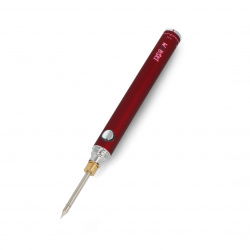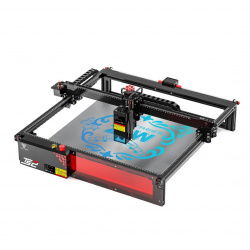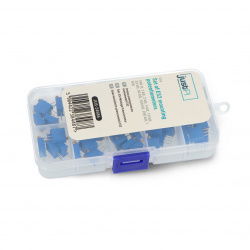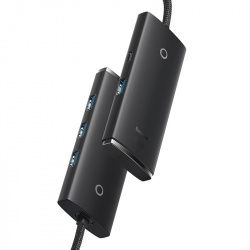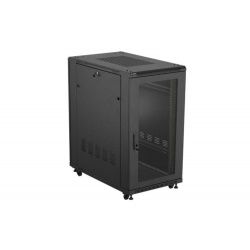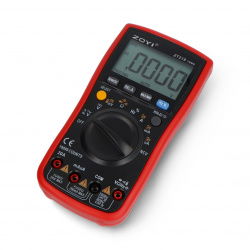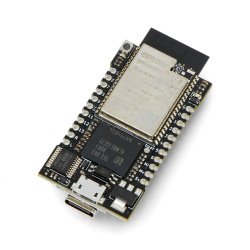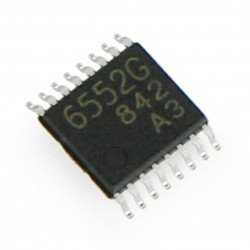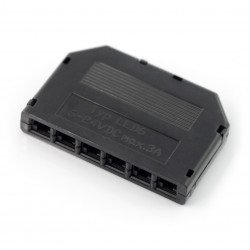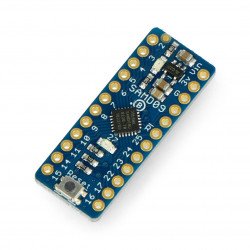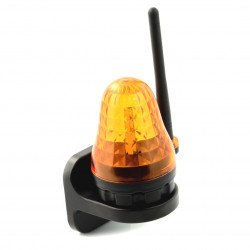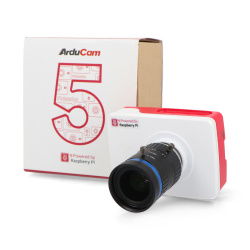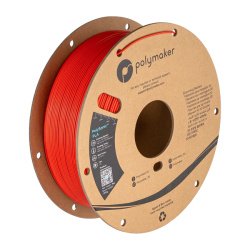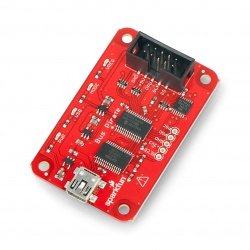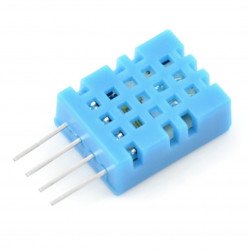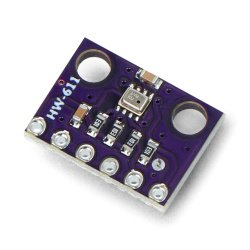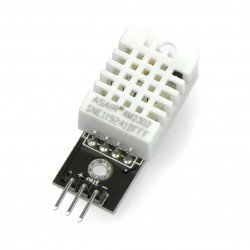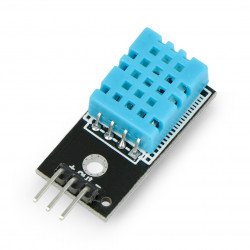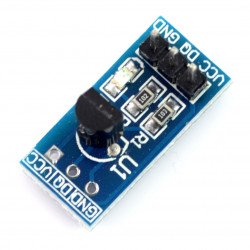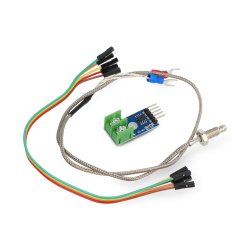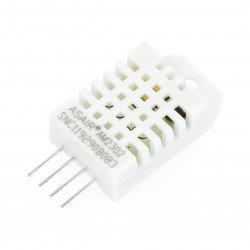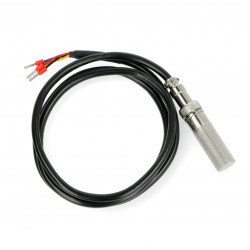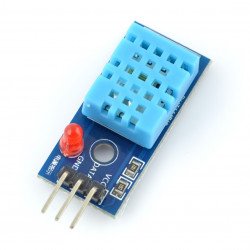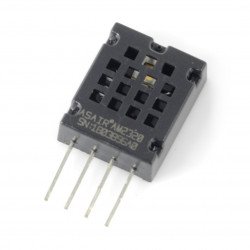Digital temperature sensors allow to perform more complex measurements and work with the already obtained measurements may be easier than in the case of analog counterparts. The output signal of the digital sensors is transmitted as a string of bits, and their interpretation will need some digital layout.
Digital temperature sensors
Temperature and humidity sensor DHT11 + 50C
Popular temperature and humidity sensor with a digital, single wired interface. Measurement range: temperature 0°C to +50 °C, humidity 20% to 90% RH .BME280 - humidity, temperature and pressure sensor 110 kPa I2C / SPI - 3.3V - soldered connectors
Very easy to use temperature, humidity and pressure sensor. The module is powered by 3.3 V and can also communicate via I2C or SPI interface . Sensors of this type are...BME280 - humidity, temperature and pressure sensor 110 kPa I2C / SPI - 3.3V
Humidity, temperature and pressure sensor powered with the voltage of 3.3 V with I2C and SPI interface. Measuring range: temperature: -40 °C to 85 °C, humidity: 10% RH to 100%...DS18B20 temperature sensor + 4,7kΩ resistors
This kit consists of one temperature sensor DS18B20 with the 1-wire interface and ten resistors of 4.7 kΩ in the through-hole case.BMP280 - digital barometer, pressure sensor 110kPa I2C/SPI 3,3V
Based on the BMP280 digital pressure sensor with an accuracy of 1 hPa. It has a built-in temperature sensor. The system communicates via the I2C or SPI bus. Measurement range...Temperature and humidity sensor DHT22 (AM2302) - module + cables
Module with temperature and humidity sensor with a digital interface, single-wired. Measuring range: temperature -40 to +80 °C, humidity 0-100% RH.BleBox Probe - waterproof temperature probe for BleBox sensors - 5m
A waterproof temperature probe manufactured in Poland by BleBox. Designed for BleBox thermoBox and saunaBox sensors. The BleBox Probe allows for temperature readings in...Temperature and humidity sensor DHT11 - module + wires
Module with temperature and humidity sensor with a digital interface. Measuring range: temperature 0-50 °C, humidity of 20-90 %RH . It has connectors for connecting the sensor...Temperature sensor DS18B20+ module - blue
Module with digital thermometer DS18B20+, equipped with 1-wire interface. The measuring range is from -55 °C to 125 °C, the supply voltage is 3.0 V to 5.5 VMAX6675 thermocouple - SPI temperature sensor
MAX6675 module along with a thermocouple allows for the measurement of high temperatures with high accuracy. It operates in the range of 0 °C to 800 °C, with a voltage from 3 V...Temperature and humidity sensor DHT22 (AM2302)
Popular temperature and humidity sensor with digital interface, jednoprzewodowym . Measuring range: temperature from -40 to 80 °C, humidity 0-100% RH.SHT-30 Mesh-protected Weather-proof Temperature/Humidity Sensor - 1m - Adafruit 4099
Temperature and humidity sensor equipped with a weather-resistant metal mesh and a 1 m cable. The measurement range for temperature is from -40 °C to 125 °C, for humidity from...Temperature and humidity sensor DHT11 - blue module
Module with temperature and humidity sensor with a digital interface. Measuring range: temperature 0-50 °C, humidity of 20-90 %RH. It has connectors for connecting the sensor...Temperature and humidity sensor AM2320 - I2C
Temperature and humidity sensor, similar to the popular DHT11 or DHT 22, with digital single-wire I2C interface. Measuring range: temperature from -40 °C to +80 °C, humidity...Thermometer with LCD display from -50 °C to 100 °C - black
Digital thermometer for mounting on a panel, the LCD display. It works in the range from -50 °C to 100 °C. The probe is on a wire with a length of 1 m. The device is powered by...BleBox tempSensorAC v2 - WiFi temperature sensor, 230VAC - up to 4 temperature probes
Sensor for temperature measurement from -55°C to 125°C , allows to connect up to 4 temperature probes. Module communicates using wireless WiFi communication based on μWiFi...Temperature and humidity sensor DHT21 (AM2301) in case
Temperature and humidity sensor with a digital, single-wired interface. Measuring range: temperature -40 to 80 °C, humidity 0 to 100 % RH . Powered with voltage in the range...CJMCU SHT10 - digital temperature and humidity sensor
Humidity and temperature sensor powered with the voltage of 3.3 V. Temperature measurement range is from -40 °C to + 123,8 °C, for the humidity is from 0 to 100 % RH.- Reduced price
- SPECIAL OFFERS
BleBox humiditySensor v2 - WiFi temperature and humidity sensor
BleBox humiditySensor v2 is a small sensor that communicates via a local WiFi network, allowing you to measure relative humidity and air temperature . Thanks to the wBox...Digital temperature and humidity sensor DHT11 - Waveshare 9535
DTH11 digital temperature and humidity sensor module from Waveshare. It enables temperature measurement from 0°C to 50°C with measurement accuracy of ± 2°C and ambient...Temperature sensor and humidity ZigBee ZTH1 Thuja Smart Life
Small size ZigBee ZTH1 humidity temperature sensor, available in white . It is powered by one 3 V CR2450 battery (supplied). It works with ZigBee 3.0. It measures...Grove AHT20 - temperature and humidity sensor - I2C - - Seeedstudio 101990644
The Grove AHT20 is a new generation sensor, enabling even more accurate measurements. The AHT20 has a newly designed ASIC with an improved MEMS semiconductor moisture...High Accuracy Digital Temperature Sensor - MCP9808 - I2C - STEMMA QT/Qwiic - Adafruit 5027
Digital temperature sensor manufactured by Adafruit. It is characterized by high precision of measurement in the range from -40°C to 125°C . The accuracy of measured values...Temperature sensor DS18B20 - black module - Iduino SE042
Module with digital thermometer DS18B20+, equipped with 1-wire interface. The measuring range is from -55 °C to 125 °C, the supply voltage is 5 V.See also
Digital temperature sensors
Digital temperature sensors are electronic elements that are used to measure the ambient temperature, and often also other physical quantities, such as air humidity or atmospheric pressure. This type of sensors requires a digital circuit to read the measured data, so it is used in projects that use communication interfaces that support such elements (e.g. I2C). The advantage of digital temperature sensors is high precision of operation, attractive price and convenience of use, as well as easy cooperation with popular minicomputers, such as Raspberry Pi.
Where are digital temperature sensors used?
Digital temperature sensors are commonly used in devices that require measurement of this physical quantity. These include, among others, household appliances, thermometers, weather stations, heating installations and air conditioning systems. This type of sensors is also often used as an element of building automation systems and smart home installations - thanks to constant access to data on the temperature in individual heating zones, it is possible to constantly adjust the intensity of heating or air conditioning. This allows you to minimize the amount of energy needed to achieve thermal comfort, which reduces the costs of operating the building. Digital sensors work exceptionally well with control systems that rely on this type of communication, which is why they are perfect for connection, for example, with the popular Raspberry Pi minicomputer.
What to pay attention to when shopping?
Digital temperature sensors and modules that measure temperature and communicate via digital interfaces are available in many variants, which are characterized by various technical parameters that determine their application. To select the right model for a specific project, it is worth paying attention to several important factors and features - including measurement range, sensor accuracy, mounting method, communication interface and power supply parameters. The temperature measurement range of digital sensors is usually similar to analog sensors and is usually in the range from -70°C to 150°C, although models are also available that can measure up to 800°C. If your project assumes the use of an integrated sensor or module and measurement of more than one value (for example, atmospheric pressure, carbon dioxide content in the air or humidity), you should check whether the measurement ranges of these values also agree with the assumptions. The accuracy of a digital temperature sensor is usually from ±0.1°C to ±3°C - however, it is worth remembering that it may depend not only on the selected sensor model, but also on other factors, for example the transducer used. It is also very important to choose a model that supports the selected communication interface and allows for convenient installation. The sensor's power supply parameters must be within the range specified by the manufacturer - otherwise the sensor will not function properly and may even be damaged, for example by being supplied with too high a voltage.
What products will you find in this section?
In this category, we offer digital temperature sensors for installation in through-hole technology (THT), integrated sensors enabling the measurement of many values at the same time (temperature, air humidity, atmospheric pressure or carbon dioxide) and modules from popular manufacturers (including the Grove, iNode and Iduino series). intended for use in electronic projects. They communicate, among others, via frequently used I2C or SPI buses, making them perfect as an element of devices such as self-built weather stations or air quality control systems. Ready-made electronic thermometers and weather stations, temperature sensors equipped with measurement probes, digital infrared temperature sensors and many other products are also available. We encourage you to familiarize yourself with our offer of digital temperature sensors, as well as the remaining range available in the Botland online store.
Digital temperature sensors - FAQ
The way digital temperature sensors work depends on the specific type of sensor. Digital temperature sensors are often used to measure the temperature in electronic devices (they provide protection against overheating and, consequently, damage to the protected parts of the system). Some sensors intended for precise temperature measurement use silicon measuring elements. The measurement process is usually based on the voltage relationship (emitter-base) or the voltage difference between the transistor junctions. As the temperature increases, the voltage between the base and emitter decreases. In turn, a drop in temperature causes an increase in voltage.
The choice of a temperature sensor should, first of all, be appropriately adapted to the specific application (how the sensor is used). When choosing a sensor, you should pay attention not only to the measurement range, which should be adapted to our expectations, but also to the measurement accuracy. Other important factors determining the choice of a temperature sensor are the installation method, power supply parameters, and the interface responsible for communication.
The most common symptoms of a damaged liquid temperature sensor include incorrect readings (too high or too low). Additionally, damaged sensors sometimes show correct temperatures and sometimes incorrect ones.






























































































































































































































































































































